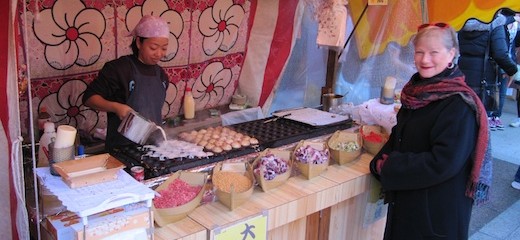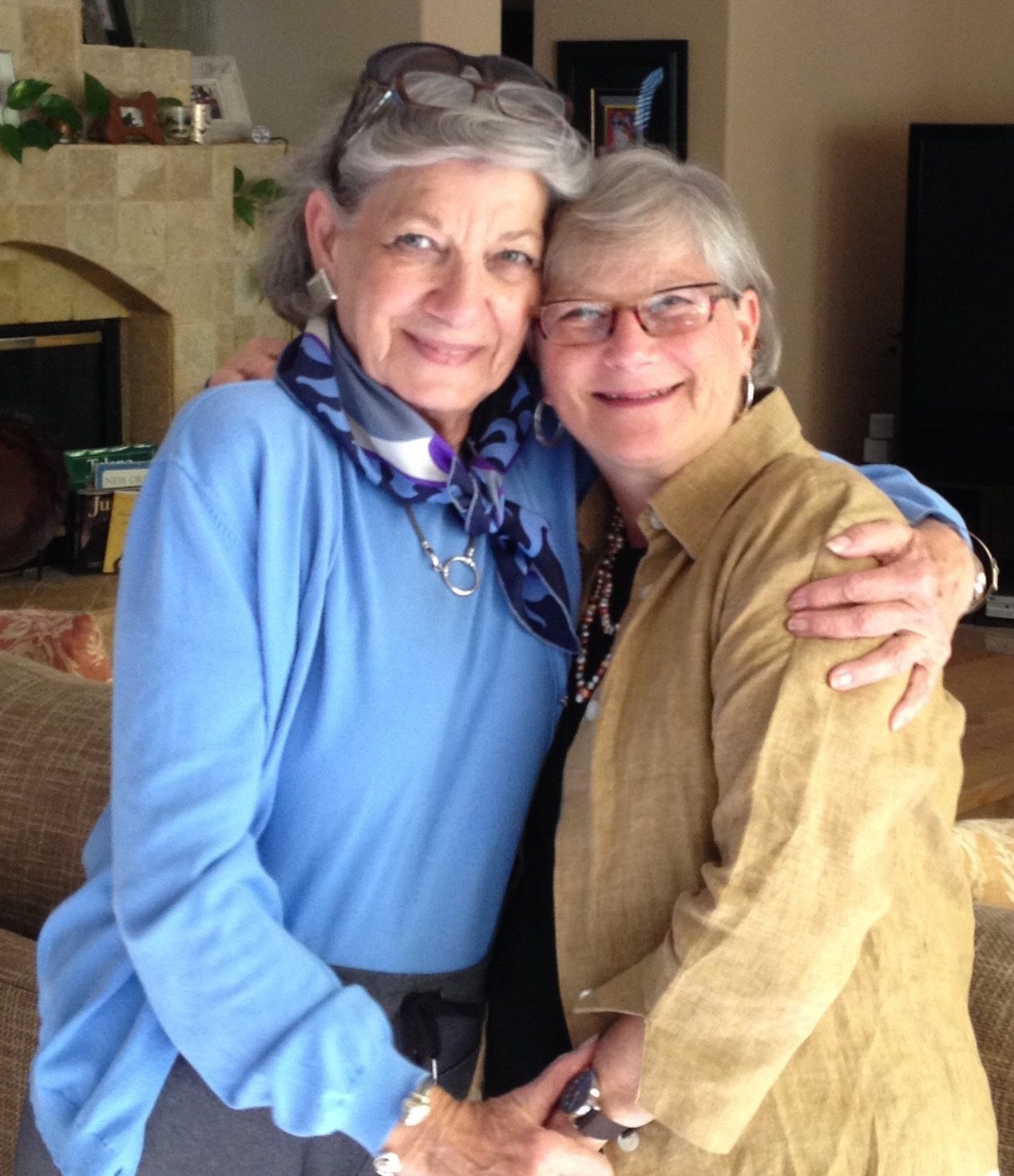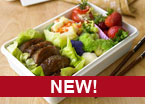Cooking (and dining) from Japan
From young foreign visitor to regular resident to cookbook author, she has relished the foods of her second home
By Debra Samuels Globe Correspondent October 11, 2011
TOKYO – At the tiny hole-in-the-wall restaurant in Ameyoko, a warren of open-air wholesale food stalls in an urban shopping area, the line snakes down the alley. Diners are willing to wait for one of 12 counter seats and gargantuan gyoza, also known as pot stickers, pleated pillows stuffed with a savory pork filling.
This is always our first stop when we return to Tokyo, which is our second hometown (our first is Lexington). I have been coming to our adopted country for 40 years with my husband, Dick, a university professor. He’s on sabbatical and we are back for a six-month stay. We have lived here for a total of 11 years and this month, I wrote about all my culinary experiences in “My Japanese Table,’’ beginning with a breakfast of grilled fish, rice, pickles, and miso soup from our very first home stay in a rural area on the southern island, Kyushu. There wasn’t a single item in the bowl that I could identify. My education had begun.
After all this time, and having lived through many faux pas – I learned that you never stick your chopsticks’ points down in the food, you do slurp noodles, and you don’t finish everything on your plate – I mastered the essentials of home cooking and began teaching in Boston. In our American kitchen, miso soup became a staple. The fried noodle dish yakisoba, originally street food, is another favorite, as is roll-your-own sushi and, of course, pot stickers. Both yakisoba and gyoza, by the way, have Chinese origins, but the Japanese have put their own spin on them.
Photos: Cooking (and dining) lessons from Japan
We first went to Japan as young married students on a Colgate University study abroad program. We were high school sweethearts from Long Island, N.Y., and I had never been out of the country. I grew up with standard American fare mixed with my family’s Eastern European Jewish cuisine. The only spices in my mother’s pantry were salt, pepper, and paprika. With one year of Japanese language at home, then one month of intensive classes at a Tokyo language school, we began our stay, not knowing at the time that it would extend over so many decades.
Five years later, with a 5-month-old baby in tow, we returned so Dick could write his dissertation. “What will the baby eat?’’ my mother said.
“Tofu,’’ I replied. She cried.
As it turned out, Brad’s first food was minuscule boiled whitebait mixed into rice porridge. “Brain food,’’ said my neighbor Kai-san, who became my lifeline. I shopped daily with a group of mothers, babies strapped to our backs while we rode on adult tricycles with huge baskets between the back wheels. These women tutored me in the markets and kitchen, and included our little family in the rhythms of their lives.
On our third trip, we sent Brad, then 6, to a Japanese first grade while Alex, 3, soaked up Japanese culture with me. They snacked on squid (ika) jerky, octopus (tako) fritters, and seaweed wrapped rice balls (onigiri). I studied Japanese cuisine formally in a class with all local women, and informally in the kitchens of friends and from vendors passing on tips as I shopped.
I learned the importance of aesthetics in a meal through Brad’s lunches. His brown bag of PB&J sandwich, carrot sticks, an Oreo, and a whole apple, was not nearly as interesting or complicated as the other children’s lunches. Next day I put the same contents in a McDonald’s bag, and he announced, “Not cute.’’ A neighbor I turned to for advice took us to get the book “100 Ways to Make Obento,’’ about packing lunches. We bought a lunch box in the shape of a VW Bug. For the rest of the year I worked my way though the book. Brad’s little Bug came back empty, so the aesthetics and effort seemed to be appreciated.
Among the other lessons I learned was how to season food, how to balance what goes on the plate or into the bowl, how to make a variety of things using different cooking methods, how to make it nutritious, and how to present it.
If you have five colors in a dish – red, black, white, yellow, and green – you have a nutritious meal. In Japan and other Asian cultures, this is based on the concept of balancing opposites, yin and yang. When you ask a Japanese person about the most important thing in planning a meal, you’ll often hear about color.
The colors correspond to three different groups. They are the five elements in nature: wood, fire, earth, metal, and water; the five human organs: liver, heart, stomach, lungs, and kidney; the five tastes: sour, bitter, sweet, hot, and salty.
Today in Tokyo, I still shop almost daily for the evening meal, stopping by a small tofu shop, going to the food fairyland in department store basements. Things have changed in Japan, too. I no longer need to go to Meidi-Ya or Kinokuniya to buy foreign foods. If I am making an American recipe, I can find most of the ingredients at a good supermarket. I can also order a whole fresh turkey for a Thanksgiving-style feast, which I make for everyone who comes to our apartment, whatever the month.
Dick and I know the city well enough so we can dine inexpensively at food stalls like the one where we go for pot stickers. We can also find kushiage joints, which serve the crispiest panko-breaded morsels on a stick, from a single asparagus spear to a quail egg. And we love izakaya (pub) style dining, a creative cuisine that marries Japanese and Western ingredients on small plates. My favorite is spicy cod roe tossed with hot pasta in cream sauce, garnished with a rainfall of shredded seaweed. We also love the casual kaiten sushi shops, where plates of nigiri sushi move by on a conveyor belt.
My favorite sushi restaurant is a tiny shop that you practically need a password to get into (a friend took me the first time). It’s under the railroad tracks at the Okachimachi station. Wooden doors with glass panels slide open and chef Hiroshi Kagawa is inside, standing in a small spot shaping rice and raw fish like a sculptor. We just say, “Omakase’’ (chef’s choice), then spend the evening swooning as we bite into otoro, the fattiest, most delicious, and expensive part of the tuna.
Things have changed dramatically at home, too, since we first started this adventure. When we return to Lexington, we find tofu, edamame, panko, wasabi, teriyaki sauce, and nori in the supermarket, along with sushi. Ten-year-old kids toss around words like udon and ramen.
Even my mother has come around. She’s a big fan of salmon teriyaki. But she still can’t get over what the boys ate as babies.
And she still won’t touch tofu.












 Debra Samuels, bestselling author, food writer and cooking instructor,
Debra Samuels, bestselling author, food writer and cooking instructor,